- Details
- Written by: Elmazen
- Category: Flags of Countries of the World
- Hits: 790
Flag of Poland, Currency, Population, Tourist Places
Explore : Flag of Poland, Currency, Population, Tourist Places, Borders, Culture
Discovering Poland: A Country Rich in History, Culture, and Natural Beauty
Poland, located in Central Europe, is a country known for its rich history, dynamic culture, scenic landscapes, and welcoming atmosphere.
Here’s a deep dive into what makes Poland such a unique and fascinating destination.
Flag of Poland, Currency, Population, Tourist Places
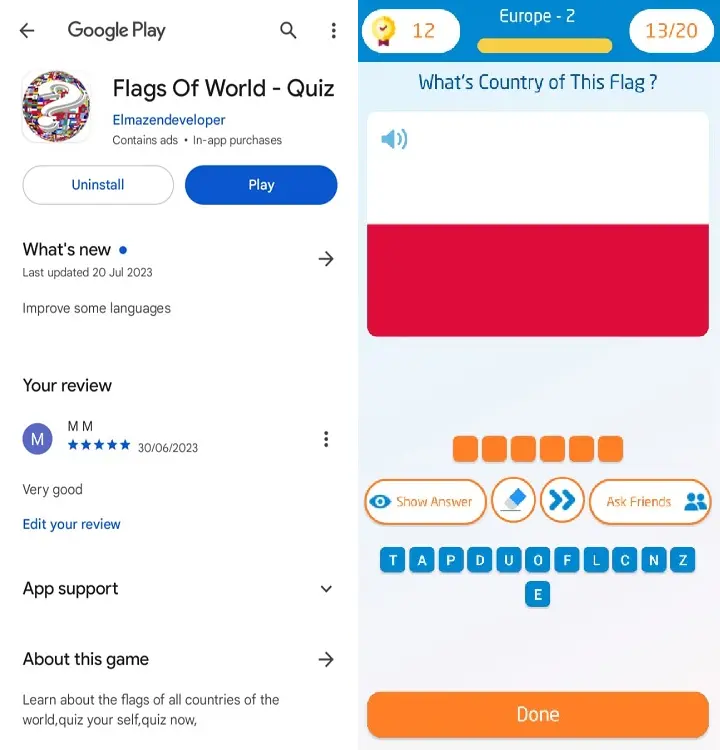
Download the application  Flags Of World - Quiz ,
Flags Of World - Quiz ,
And test your knowledge with Flags of World ,
1. Population of Poland :
As of December 2024, Poland's population is around 38.36 million people.
The majority of the population resides in urban areas, with Warsaw as the largest city and the capital, followed by Kraków, Łódź, and Wrocław.
Poland's population growth is relatively stable, with occasional fluctuations due to migration trends.
2. The Polish Flag and Its Meaning :
The flag of Poland is composed of two horizontal stripes: white on top and red on the bottom.
These colors are deeply rooted in Polish history and symbolize purity and valor.
The white represents the hope and peaceful nature of the Polish people, while the red symbolizes the bloodshed of those who fought for Poland's independence.
This combination of colors dates back centuries and remains an important national symbol of Polish identity and pride.
3. Currency of Poland :
Poland’s official currency is the Polish złoty (PLN).
One złoty is divided into 100 groszy, and the currency is widely recognized for its stability and strong presence in the Polish economy.
The złoty has served Poland well, even as the country joined the European Union in 2004, as Poland continues to retain its currency while EU integration deepens.
Flag of Poland, Currency, Population, Tourist Places

Download the application  Flags Of World - Quiz ,
Flags Of World - Quiz ,
And test your knowledge with Flags of World ,
4. Poland’s Borders :
Poland shares its borders with seven countries :
Germany : to the west,
Czech Republic : and Slovakia to the south,
Ukraine : and Belarus to the east,
Lithuania : and the Russian exclave of Kaliningrad to the northeast.
Additionally, Poland has access to the Baltic Sea in the north, which has been instrumental in its trade and maritime culture.
These borders and the strategic location in Central Europe have played a major role in Poland's cultural and economic exchanges throughout history.
5. Culture of Poland :
Poland’s culture is a blend of Eastern and Western European influences with a strong emphasis on family, religion, and traditional values.
Polish culture is rooted in Catholicism, with the majority of Poles identifying as Catholic.
The country celebrates a variety of religious and national holidays, and many traditional customs are observed across generations.
Polish music, literature, and art have a rich heritage, with prominent figures like composer Frédéric Chopin and writer Adam Mickiewicz influencing global arts.
Poland also has a thriving folk culture, with vibrant costumes, dances, and handcrafted decorations.
The Polish language is part of the Slavic language family and is spoken by nearly the entire population, adding a unique linguistic identity to the country.
Polish cuisine is another cultural cornerstone, with hearty dishes like pierogi (dumplings), bigos (hunter’s stew), and żurek (sour rye soup) being among the most popular.
These dishes showcase a blend of Slavic, German, and Jewish culinary traditions.
6. Best Places to Visit in Poland :
Poland offers a diverse array of landscapes, historical sites, and architectural gems.
Some of the top destinations include:
Kraków :
Known for its stunning Old Town, which is a UNESCO World Heritage Site, and Wawel Castle, Kraków is a city full of medieval charm and vibrant culture.
Warsaw :
Poland's capital, known for its mix of historic and modern architecture.
The Warsaw Old Town has been meticulously restored and offers a look at the city's resilience.
Auschwitz-Birkenau :
The former Nazi concentration camp serves as a deeply moving memorial and museum, reminding visitors of the atrocities of World War II.
Wrocław :
Famous for its beautiful Market Square, gothic architecture, and the many charming bridges that cross the Oder River, Wrocław is a delight to explore.
Gdańsk :
This port city on the Baltic coast is known for its maritime heritage, colorful facades, and historical significance in the Solidarity movement.
Zakopane :
Located in the Tatra Mountains, Zakopane is a popular destination for skiing in the winter and hiking in the summer, offering breathtaking mountain views and a taste of Polish highlander culture.
Białowieża Forest :
A UNESCO-listed forest and one of Europe’s last primeval forests, it’s home to the endangered European bison and offers incredible natural beauty.
Each destination offers a unique glimpse into Poland’s history, culture, and natural landscapes, making the country a remarkable and rewarding place to explore.
Whether interested in history, nature, or vibrant city life, Poland has something special for everyone.
Flag of Poland, Currency, Population, Tourist Places

Download the application  Flags Of World - Quiz ,
Flags Of World - Quiz ,
And test your knowledge with Flags of World ,
- Details
- Written by: Elmazen
- Category: Flags of Countries of the World
- Hits: 761
Flag of Norway, Currency, Population, Tourist Places
Exploring Norway: Population, Flag, Currency, Borders, Culture, and Top Destinations
Norway, a country known for its breathtaking landscapes, rich culture, and vibrant history, is a must-visit destination in northern Europe.
From its majestic fjords to its progressive social policies, Norway offers a unique blend of natural beauty, modernity, and tradition.
Let’s dive into some fascinating details about Norway.
Flag of Norway, Currency, Population, Tourist Places
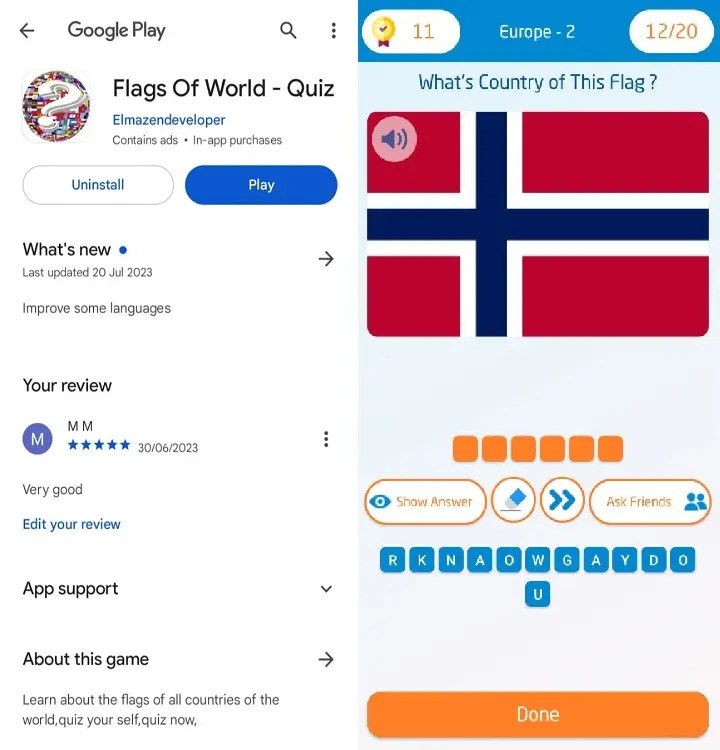
Download the application  Flags Of World - Quiz ,
Flags Of World - Quiz ,
And test your knowledge with Flags of World ,
1. Population of Norway :
As of December 2024, Norway has population of around 5.6 million people.
Although it’s one of the most sparsely populated countries in Europe due to its large land area, its urban centers like Oslo, Bergen, and Stavanger are bustling with activity.
Norway’s population is spread across beautiful coastal cities and rural villages, creating a balance of urban and rural living.
2. Norway’s Flag and Its Meaning :
Norway’s flag is iconic, featuring a red background with a blue cross outlined in white.
The flag symbolizes Norway’s heritage and its connections with other Scandinavian countries like Sweden and Denmark, as they share similar flag designs.
Here’s what each color represents:
Red : A symbol of courage and strength.
White : Purity and peace.
Blue : Loyalty, truth, and justice.
The cross design itself reflects Norway’s historical ties with other Scandinavian nations, as all Scandinavian flags incorporate a cross in their designs.
3. Currency of Norway :
The official currency of Norway is the Norwegian Krone (NOK), commonly represented with the symbol “kr”.
Known for its economic stability, Norway has retained its currency rather than adopting the Euro, despite being part of the European Economic Area (EEA).
The krone is further divided into 100 øre, though øre coins are no longer in circulation.
Flag of Norway, Currency, Population, Tourist Places

Download the application  Flags Of World - Quiz ,
Flags Of World - Quiz ,
And test your knowledge with Flags of World ,
4. Norway’s Borders :
Norway is located on the Scandinavian Peninsula in Northern Europe, bordered by:
Sweden : to the east,
Finland : and Russia to the far northeast,
It also has extensive coastlines along the North Sea and the Norwegian Sea to the west.
Its proximity to the Arctic Circle gives Norway a unique climate, with colder northern regions and a more temperate southern coast.
5. The Culture of Norway :
The culture of Norway is rich in history and deeply tied to nature and traditions. Key elements include:
Norwegian Language and Literature : Norwegian is the official language, with two written forms, Bokmål and Nynorsk.
Norway also has a strong literary tradition, with famous authors like Henrik Ibsen known worldwide.
Viking Heritage : Norway has a fascinating Viking history, celebrated through numerous museums and events.
This heritage influences much of Norway’s cultural identity today, with a focus on adventure, seafaring, and exploration.
National Holidays and Traditions : May 17th, known as Constitution Day, is Norway's National Day and is celebrated with parades, traditional costumes called "bunads," and gatherings across the country.
Outdoor and Nature-Loving Culture : Norwegians place a high value on outdoor activities like hiking, skiing, and fishing.
(free air life) is a philosophy promoting outdoor activities as a source of well-being.
6. Best Places to Visit in Norway :
Norway is renowned for its natural beauty, making it a dream destination for travelers who appreciate the outdoors and history.
Here are some top places to visit:
Oslo :
The capital city is a hub for art, culture, and history.
The Viking Ship Museum, the Munch Museum, and the Oslo Opera House are must-sees for any visitor.
Bergen :
Known for its colorful wharf, Bryggen, and surrounded by fjords and mountains, Bergen is perfect for scenic walks and exploring Norway’s maritime history.
Geirangerfjord :
A UNESCO World Heritage site, Geirangerfjord is famed for its stunning views, waterfalls, and dramatic cliffs.
Lofoten Islands :
This stunning archipelago in the north offers breathtaking landscapes, fishing villages, and opportunities to see the Northern Lights.
Tromsø :
Known as the gateway to the Arctic, Tromsø offers activities like dog sledding, whale watching, and exceptional views of the Northern Lights in winter.
The Sognefjord :
Norway’s longest and deepest fjord, Sognefjord is an ideal spot for hiking, boat tours, and experiencing Norwegian nature at its best.
Norway combines natural beauty, a proud heritage, and a deep-rooted cultural identity, making it a remarkable place to explore.
Whether you’re captivated by the fjords or the Northern Lights, Norway is a country that promises memorable experiences at every turn.
Flag of Norway, Currency, Population, Tourist Places

Download the application  Flags Of World - Quiz ,
Flags Of World - Quiz ,
And test your knowledge with Flags of World ,
- Details
- Written by: Elmazen
- Category: Flags of Countries of the World
- Hits: 786
Flag of North Macedonia
Explore : Flag of North Macedonia, Currency, Population, Tourist Places, Borders, Culture
North Macedonia: A Guide to the Country
North Macedonia, officially known as the Republic of North Macedonia, is a captivating nation in the Balkan Peninsula.
From its rich history and vibrant culture to breathtaking landscapes, North Macedonia has much to offer.
Flag of North Macedonia, Currency, Population, Tourist Places
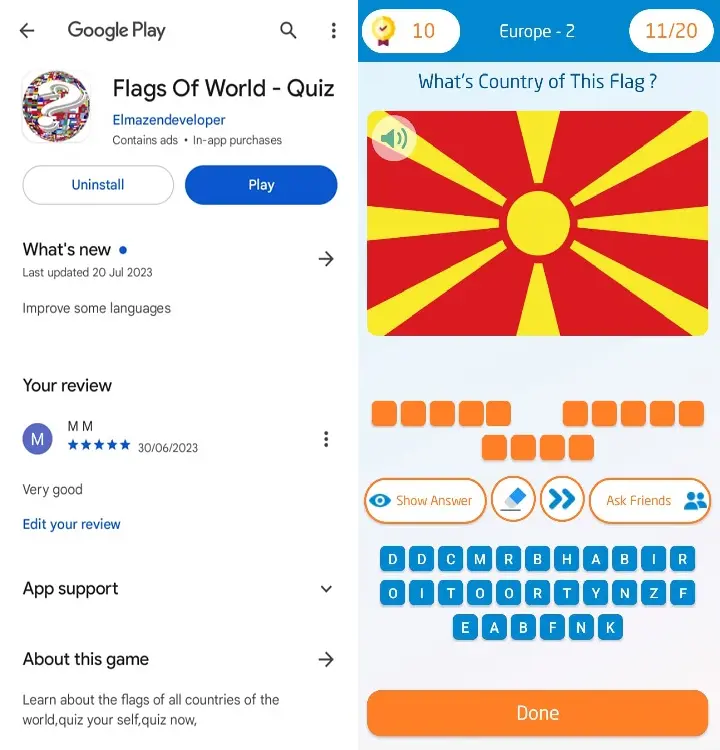
Download the application  Flags Of World - Quiz ,
Flags Of World - Quiz ,
And test your knowledge with Flags of World ,
1. Population of North Macedonia :
As of December 2024, North Macedonia has a population of approximately 1.818 million people.
This relatively small population is known for its diversity, as the country is home to several ethnic groups, including Macedonians, Albanians, Turks, and Romani.
2. The Flag of North Macedonia and Its Meaning :
The North Macedonian flag is simple yet striking: it features a yellow sun with eight rays extending to the edges of a red field.
Adopted in 1995, this sun represents the "new sun of liberty" mentioned in the national anthem.
Each ray symbolizes hope, freedom, and unity, embodying the country's aspirations and resilience.
3. North Macedonia's Currency :
The currency used in North Macedonia is the Macedonian denar, abbreviated as MKD.
One denar is subdivided into 100 deni. The currency has been in circulation since 1993 and is essential for transactions in the country, though some businesses in tourist areas may also accept euros.
Flag of North Macedonia, Currency, Population, Tourist Places

Download the application  Flags Of World - Quiz ,
Flags Of World - Quiz ,
And test your knowledge with Flags of World ,
4. Borders of North Macedonia :
North Macedonia is a landlocked country bordered by five nations:
Serbia : to the north,
Kosovo : to the northwest,
Bulgaria : to the east,
Greece : to the south,
Albania : to the west.
Its location in the heart of the Balkans has historically made it a crossroad for trade, culture, and migration.
5. Culture of North Macedonia :
North Macedonian culture is a blend of various influences, thanks to its position as a meeting point between Eastern and Western traditions.
Predominantly Orthodox Christian, the nation celebrates many religious and cultural festivals throughout the year.
Music, dance, and art are integral to its cultural identity, with the traditional Macedonian dance "oro" being a popular performance during celebrations.
Turkish, Byzantine, and Slavic influences are evident in its cuisine, architecture, and traditions.
6. Best Places to Visit in North Macedonia :
Ohrid :
A UNESCO World Heritage site known for its ancient churches, monasteries, and the beautiful Lake Ohrid, one of the oldest and deepest lakes in Europe.
Skopje :
The capital city, famous for its vibrant markets, historical sites like the Stone Bridge, and a modern cultural scene.
Mavrovo National Park :
Ideal for nature lovers and adventure enthusiasts, offering hiking, skiing, and incredible scenery.
Bitola :
Known as the "City of Consuls," Bitola features beautiful Ottoman architecture, historic mosques, and a laid-back atmosphere.
Kratovo :
A small town in a volcanic crater known for its unique stone towers and bridges, giving it a medieval charm.
Final :
North Macedonia is a country with a rich heritage, scenic landscapes, and welcoming people.
It offers a blend of history, culture, and natural beauty that makes it an intriguing destination.
Flag of North Macedonia, Currency, Population, Tourist Places

Download the application  Flags Of World - Quiz ,
Flags Of World - Quiz ,
And test your knowledge with Flags of World ,
- Details
- Written by: Elmazen
- Category: Flags of Countries of the World
- Hits: 856
Flag of Netherlands
Flag of Netherlands, Currency, Population, Tourist Places, Borders, Culture
The Netherlands: A Detailed Overview
The Netherlands, also known informally as Holland, is a fascinating European country with rich cultural heritage, a vibrant history, and beautiful landscapes.
Whether you're planning a visit or simply curious, this article covers key aspects of the Netherlands, including population, flag, currency, borders, culture, and must-see destinations.
Flag of the Netherlands, Currency, Population, Tourist Places
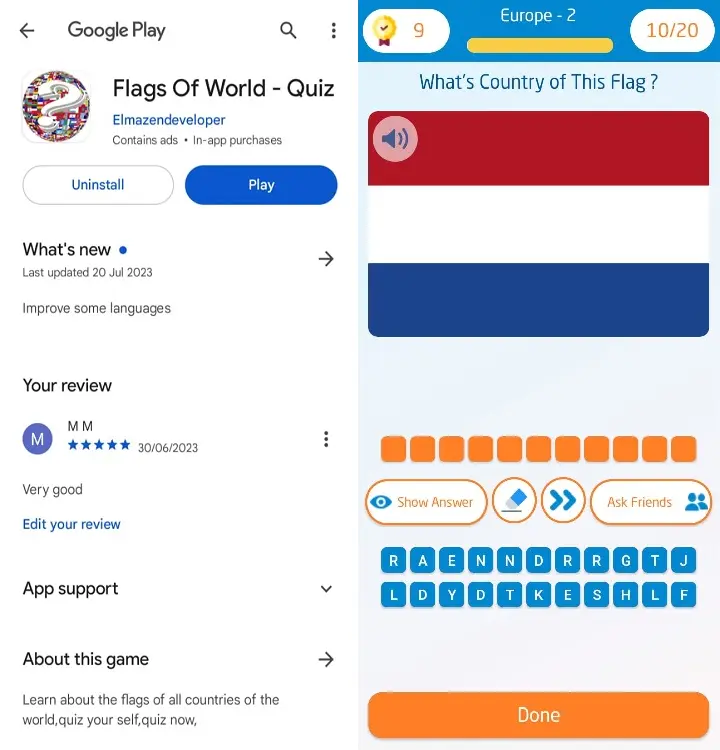
Download the application  Flags Of World - Quiz ,
Flags Of World - Quiz ,
And test your knowledge with Flags of World ,
1. Population of the Netherlands :
As of December 2024, the population of the Netherlands is approximately 18.28 million people.
It is a densely populated country, with a majority of residents living in urban areas.
Major cities like Amsterdam, Rotterdam, The Hague, and Utrecht are central hubs of activity, commerce, and culture.
The population is diverse, with a mix of Dutch nationals and immigrants from various countries, contributing to its multicultural character.
2. Meaning of the Netherlands Flag :
The flag of the Netherlands consists of three horizontal stripes: red (top), white (middle), and blue (bottom).
The flag's colors date back to the 16th century, during the Dutch War of Independence.
The colors are thought to represent various elements:
Red : Originally orange, symbolizing the Dutch royal family and the Prince of Orange who led the revolt against Spanish rule.
It was later changed to red.
White : Represents peace and honesty.
Blue : Symbolizes loyalty, justice, and vigilance.
The Dutch flag is simple but significant, reflecting the country's history of independence and unity.
3. Currency of the Netherlands :
The official currency of the Netherlands is the Euro (€), abbreviated as EUR.
The Netherlands adopted the Euro in 2002, as part of its membership in the European Union (EU).
Before the Euro, the Dutch used the guilder (gulden), which had been the country's currency for several centuries.
Flag of the Netherlands, Currency, Population, Tourist Places

Download the application  Flags Of World - Quiz ,
Flags Of World - Quiz ,
And test your knowledge with Flags of World ,
4. Borders of the Netherlands :
The Netherlands is located in Northwestern Europe and shares land borders with two countries:
Germany : to the east.
Belgium : to the south.
Additionally, the country is bordered by the North Sea to the north and west, giving it a long coastline.
Its strategic location has made the Netherlands an important trading hub throughout history.
5. Culture of the Netherlands :
The culture of the Netherlands is renowned for its emphasis on tolerance, openness, and innovation.
Some key cultural elements include:
Language : The official language is Dutch, but English is widely spoken, particularly in business and tourism.
Frisian is also spoken in the Friesland province.
Art and Architecture : The Netherlands has produced some of the world’s most famous artists, including Vincent van Gogh, Rembrandt, and Johannes Vermeer.
Dutch architecture, with its iconic canal houses and windmills, is also globally recognized.
Festivals and Traditions : The Dutch celebrate many festivals, such as King’s Day (Koningsdag), where the entire country dons orange clothing to honor the royal family, and Sinterklaas (a Dutch Santa Claus celebration) in early December.
The Dutch are also known for their love of cycling, and bicycles are an essential part of daily life.
Cuisine : Dutch cuisine is simple but hearty.
Traditional dishes include stroopwafels (thin caramel-filled waffles), herring (often eaten raw), and bitterballen (fried meatballs).
Dutch cheese, such as Gouda and Edam, is world-famous.
6. Best Places to Visit in the Netherlands :
The Netherlands offers a wide range of attractions, from picturesque cities to natural landscapes.
Some of the best places to visit include:
Amsterdam :
The capital city is known for its historic canals, world-class museums like the Rijksmuseum and the Van Gogh Museum, and its vibrant nightlife.
Rotterdam :
Famous for its modern architecture and major port, Rotterdam is a hub of innovation and culture.
The Cube Houses and the Erasmus Bridge are architectural highlights.
Keukenhof Gardens :
Known as the "Garden of Europe," Keukenhof is home to millions of blooming tulips in the spring.
It is one of the most beautiful gardens in the world.
Zaanse Schans :
A traditional Dutch village with well-preserved windmills, wooden houses, and museums showcasing the Netherlands' industrial heritage.
The Hague :
The seat of the Dutch government and the royal family, The Hague is home to the International Court of Justice and the stunning Peace Palace.
Utrecht :
Known for its medieval city center and beautiful canals, Utrecht is a charming city with a vibrant student population.
Giethoorn :
Often called the “Venice of the North,” this village is famous for its waterways and thatched-roof houses.
Visitors can explore by boat, as there are no roads in the village center.
Texel Island :
One of the Dutch Wadden Islands, Texel is a great place for nature lovers.
It offers beautiful beaches, nature reserves, and opportunities for cycling and bird watching.
Conclusion :
The Netherlands is a country that combines modernity with rich history and traditions.
With its welcoming people, unique culture, and numerous attractions, it’s a destination worth exploring.
From the bustling streets of Amsterdam to the peaceful canals of Giethoorn, the Netherlands has something for everyone.
Flag of the Netherlands, Currency, Population, Tourist Places

Download the application  Flags Of World - Quiz ,
Flags Of World - Quiz ,
And test your knowledge with Flags of World ,
- Details
- Written by: Elmazen
- Category: Flags of Countries of the World
- Hits: 779
Flag of Montenegro
ُExplore : Flag of Montenegro, Currency, Population, Tourist Places, Borders, Culture
Montenegro: A Fascinating Balkan Gem
Montenegro, located in Southeast Europe along the Adriatic Sea, is a small yet stunning country rich in history, culture, and natural beauty.
It has become a beloved destination for travelers due to its picturesque landscapes, diverse heritage, and welcoming atmosphere.
In this article, we’ll explore various aspects of Montenegro, from its population to its vibrant culture and must-see destinations.
Flag of Montenegro, Currency, Population, Tourist Places
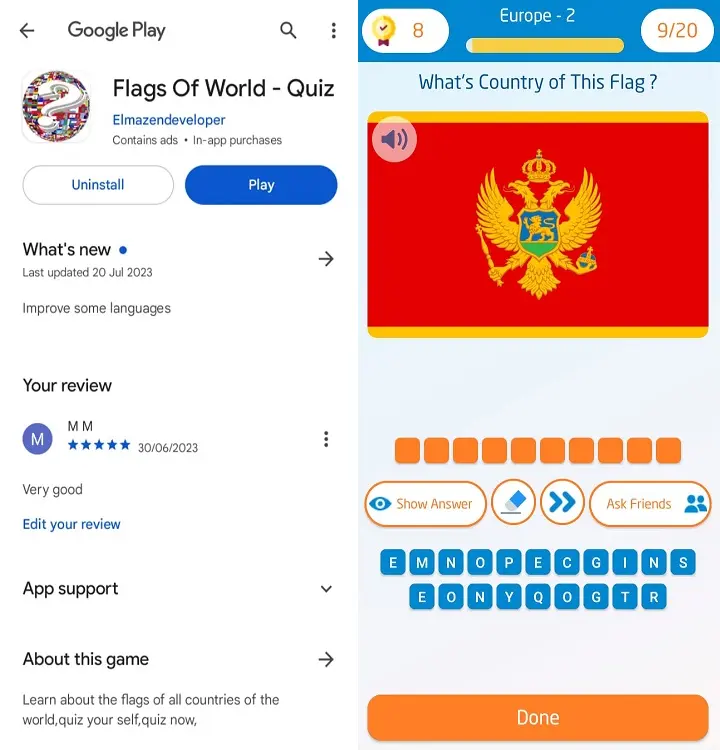
Download the application  Flags Of World - Quiz ,
Flags Of World - Quiz ,
And test your knowledge with Flags of World ,
1. Population of Montenegro :
As of December 2024, Montenegro's population is approximately 635,900 people.
The population is relatively small compared to its neighboring countries, but Montenegro is a diverse nation, with a mix of ethnic groups including Montenegrins, Serbs, Bosniaks, Albanians, and Croats.
The capital and largest city, Podgorica, is home to around 30% of the population.
2. Montenegro’s Flag and its Meaning :
The flag of Montenegro is a red field with a gold border, featuring the country's coat of arms at the center.
The coat of arms showcases a golden double-headed eagle, symbolizing Montenegro's historical connection to the Byzantine Empire, with a shield in the middle depicting a lion passant, a symbol of power and independence.
The red and gold colors represent the traditional colors of the Montenegrin royal family and stand for courage, strength, and sovereignty.
This flag was officially adopted on July 13, 2004.
3. Montenegro’s Currency :
The official currency of Montenegro is the Euro (€), even though the country is not a member of the European Union (EU) or the Eurozone.
Montenegro unilaterally adopted the euro in 2002, replacing the Deutsche Mark, which had been in use since the 1990s.
This adoption was motivated by the country’s economic ties with the EU.
Flag of Montenegro, Currency, Population, Tourist Places

Download the application  Flags Of World - Quiz ,
Flags Of World - Quiz ,
And test your knowledge with Flags of World ,
4. Montenegro’s Borders :
Montenegro is a small, land and sea bordered country in the Balkans.
It shares land borders with:
Croatia : to the west,
Bosnia and Herzegovina : to the northwest,
Serbia : to the northeast,
Kosovo : to the east,
Albania : to the southeast,
To the southwest, Montenegro’s coast opens up to the Adriatic Sea, giving it stunning beaches and strategic access to maritime routes.
This combination of mountainous inland regions and coastal areas gives Montenegro an incredibly diverse geography.
5. Culture of Montenegro :
Montenegro's culture is a vibrant blend of influences from its Slavic roots, Ottoman heritage, and Mediterranean connections.
The people of Montenegro are known for their warm hospitality, pride in their history, and love for traditions.
Key aspects of the culture include:
Folk music and dances : Montenegrin music is largely influenced by its folklore, with traditional instruments like the gusle (a single-stringed instrument) being popular in storytelling and celebrations.
Cuisine : Montenegrin cuisine is diverse and heavily influenced by Mediterranean, Eastern European, and Ottoman flavors.
Expect to find dishes like lamb cooked under the sač (a bell-shaped lid), seafood along the Adriatic coast, and hearty stews and smoked meats in the mountainous regions.
Religion : The majority of Montenegrins follow Eastern Orthodox Christianity, with a significant number of Roman Catholics and Muslims, reflecting the country's multi-ethnic and multi-religious makeup.
Montenegrin festivals and events often focus on preserving historical traditions, such as the annual "Mimosa Festival" in the coastal city of Herceg Novi or the "Ethno Jazz Festival" in Kotor.
6. Best Places to Visit in Montenegro :
Montenegro is famous for its breathtaking natural beauty, ancient cities, and serene coastal towns.
Here are some of the top places to visit:
Kotor :
A UNESCO World Heritage Site, Kotor is a stunning coastal town located in a bay surrounded by mountains.
It boasts a well-preserved medieval Old Town, featuring narrow streets, historic churches, and fortifications.
Budva :
One of the most popular destinations along the Adriatic coast, Budva is known for its vibrant nightlife, beautiful sandy beaches, and charming old town with Venetian walls.
Durmitor National Park :
A paradise for nature lovers and adventure enthusiasts, Durmitor National Park is famous for its rugged mountains, pristine lakes, and one of Europe’s deepest canyons, the Tara River Canyon.
It offers hiking, rafting, skiing, and stunning views.
Sveti Stefan :
A picturesque islet connected to the mainland by a narrow causeway, Sveti Stefan is an exclusive luxury resort that used to be a fishing village.
It is known for its red-roofed houses and crystal-clear waters.
Lake Skadar :
Straddling the border with Albania, Lake Skadar is the largest lake in the Balkans and a haven for wildlife.
Visitors can explore its wetlands, birdwatch, or take a boat tour through the beautiful scenery.
Cetinje :
Once the royal capital of Montenegro, Cetinje is full of history and culture, with important landmarks such as the Cetinje Monastery and King Nikola’s Palace, reflecting the country’s rich royal past.
Lovćen National Park :
Lovćen Mountain is central to Montenegrin identity, as it is where the country’s greatest leader, Petar II Petrović-Njegoš, is buried.
The views from the mausoleum at the summit are truly breathtaking.
Conclusion :
Montenegro, with its rich culture, breathtaking landscapes, and fascinating history, offers much more than its size suggests.
Whether you’re interested in exploring medieval towns, soaking in the sun on pristine beaches, or venturing into the mountains for outdoor adventures, this small Balkan country has something for everyone.
Its welcoming population, diverse traditions, and scenic beauty make it a top destination for any traveler.
Flag of Montenegro, Currency, Population, Tourist Places
